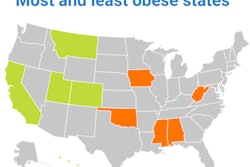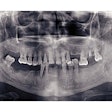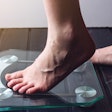
In this two-part series, a nurse and a dietitian share why it is important to screen children for obesity within your dental practice and explain how to successfully screen children. Part one focused on why dental providers can -- and should -- do weight assessments. Part two focuses on four steps dental providers can use to screen kids for obesity.
Screening for obesity within the dental practice can help prevent at-risk children from developing chronic diseases later in life, according to a session on nutrition at the recent 2016 ADA annual meeting in Denver. However, the speakers also noted that weight can be a difficult topic for dental providers to broach.
That's why presenter Ryann Diehl, RDN, LDN, outlined four steps providers can follow when screening for obesity in the dental practice. Diehl is a pediatric dietician at the University of Maryland Medical Center.
"Weight is sometimes a difficult topic to bring up, especially in a dental office," she said.
Step 1: Get accurate height and weight measurements
Height and weight are the two components needed to get a patient's body mass index (BMI) classification, which categorizes children and adults as underweight, normal/healthy weight, overweight, or obese. More information about BMI as a screening tool can be found in part one of this series.
“Weight is sometimes a difficult topic to bring up, especially in a dental office.”
Diehl stressed that puffed-up hair or a heavy winter coat could be the difference between weight classifications. To ensure you get an accurate measurement, make sure kids put their heels up against the wall and remove any oversize clothing that may affect their weight. Also make sure to measure height from the top of a child's head, not the hair.
Because screening for weight can be a sensitive experience, be mindful of where you do it. Patients won't feel at ease if they're being screened in front of everyone in the practice, Diehl noted.
In addition, once you have the height and weight, be sure to add it to the patient's chart, so you can track it over time.
When asked how to explain why your dental practice is now taking weight, Diehl said that some practices say weight is important for dosing anesthesia. However, you can also simply explain that you care about whole-body health, which includes BMI.
Step 2: Calculate BMI
Once you have the patient's height and weight, calculate the BMI. Diehl recommends using an app or online tool, which can provide an accurate number and easy-to-see classification.
It's important to note that children and adults have different steps to get their BMI classification. For children, BMI is assigned based the U.S. Centers for Disease Control and Prevention (CDC) growth chart, which can be used for children older than age 2.
It is OK to screen kids as young as age 2, because "the earlier you intervene, the earlier you can make a change," Diehl said.
She also noted that once you know the BMI classification, don't tell the patient what it is. Instead, keep the information in the back of your mind, and bring it up later in the visit after you've asked about nutrition.
Step 3: Brief nutritional intake and recommendations
Later in the visit is the best time to ask patients about their nutritional intake, including the types of beverages they drink and how often, how many meals they eat each day, and what they have for snacks. This is probably the most natural step for dental providers, who likely already ask similar questions.
Diehl recommended asking children about what they eat and drink, not the parents, because children are more likely to be honest. She also said to ask every child, regardless of BMI classification, because everyone has the opportunity to be healthier.
Once you've performed a nutritional screening, then you can provide recommendations. Diehl advised having kids write down one to two healthy living goals for themselves that they can take with them. Examples of goals include eating a fruit smoothie as an afternoon snack instead of chips, only drinking one glass of juice each day, or running the stairs during TV commercial breaks.
"Make sure you give them simple goals they can accomplish, and focus on one to two things," she said. "Give kids ownership ... and follow up."
She stressed when providing recommendations, it's important to avoid "negative language," such as "obese" or "overweight," "fat," "bad," or "large," because words like these tend to lead to an unproductive conversation rather than one focused on improvement. Instead, Diehl recommended using "leaner," "healthier," "fitter," and "stronger."
"Focus on that -- feeling healthier," she said. "It's much better to say you can feel healthier, stronger."
Diehl emphasized avoiding placing blame or using the word "diet," because the changes should be focused on the patient becoming healthier, not necessarily losing weight. There is no ideal weight, rather it's about getting to a BMI at which patients feel their healthiest and can perform their best, she noted.
"We're more interested in a child making changes to their lifestyle, rather than going on a crash diet," she said. "A lot of time the children have time to grow taller."
Step 4: Follow up with primary care when appropriate
For kids who fall into the BMI categories of overweight or obese, make sure you refer these patients to follow-up with their primary care provider, Diehl said. Primary care providers are trained to perform more nutrition and health assessments, and they can also screen patients for chronic illnesses, such as fatty liver disease and type 2 diabetes.
"We're not expecting you to do the work," Diehl said. "But we are expecting you to refer to primary care physicians."



















